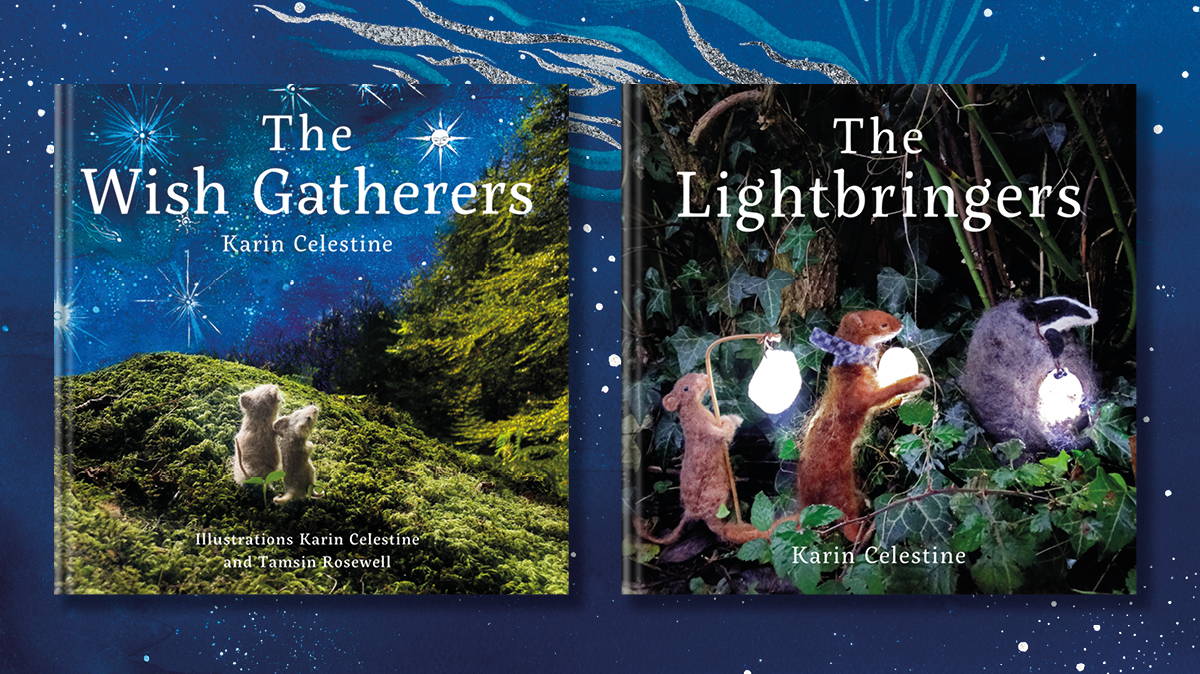With only a few weeks to go 'til the publication of The Wish Gatherers, we had the chance to pick the brains of creators Karin Celestine and Tamsin Rosewell to find out more about the picture book process, collaboration and their favourite spreads. Take a look below to find out what they had to say.
How did the idea for the Tales of the Turning Year series come about?
KC: Years ago, I made some animals for an exhibition that had little lanterns to fit with the theme they had set. I started asking myself who they were and why they were carrying lanterns and The Lightbringers story just came to me one day. I wrote it down as a blog and it was so well received that I turned it into a little story card.
When I was talking to Graffeg about what next book-wise, I suggested that perhaps there could be a series of four books, one for each season. I’d been slowly moving towards making animals linked to folklore and that liminal world between fantasy and reality, folklore, myth and story. I wanted to write more about nature and linking in the seasons and the world around us. Picture books for grown-ups. Folk customs are being lost and I love our rich traditions of these customs. So the idea of the books came about.
Where did the idea for a collaboration come from?
KC: I had the story [of The Wish Gatherers] but had the puzzle of how to photograph my creatures looking up at the night sky, or how to photograph a shooting star.
I had an idea that maybe I needed painted backdrops like a stage set, or perhaps a painting of the sky could be blended with a photograph, but wasn’t quite sure what was possible.
Tamsin had been a champion of my books previously and Kenilworth Books had hosted the Helping Hedgehog Home book launch. She had offered to paint the lovely little page toppers for The Lightbringers, so she was a natural choice to commission to paint skies and stars for the next book. I’d been chatting with Tamsin about her working more as an illustrator in the future and thought that it would be a great way for her to step into book illustration.
We chatted about how it could work and tried out a few ideas. The first idea I had was to take a painting of the sky out with me into the woods and photograph the animals with that as the backdrop, but it didn’t work for various reasons, so then I wondered if perhaps the designers at Graffeg could replace the sky in my photos with Tamsin’s paintings. I did a rough photoshop of what I meant and I thought it would work and look beautiful, so we had a zoom meeting where I tried to explain the idea to everyone. I was so nervous that what was in my head would be seen by others, but I needn’t have worried. It has turned out just beautifully.
TR: I’ve known Karin’s work since their first book, Small Finds a Home, and have always supported it. They spoke to me about an idea for a book with shooting stars and constellations – but as Karin’s own illustration is a combination of textile work and photography, it would have been hard – almost impossible in fact – to take photographs that happened to capture images of stars and meteors and also have everything in focus. So they approached me with the idea that I should somehow create the background. The difficult bit was working out how to achieve the effect we wanted.
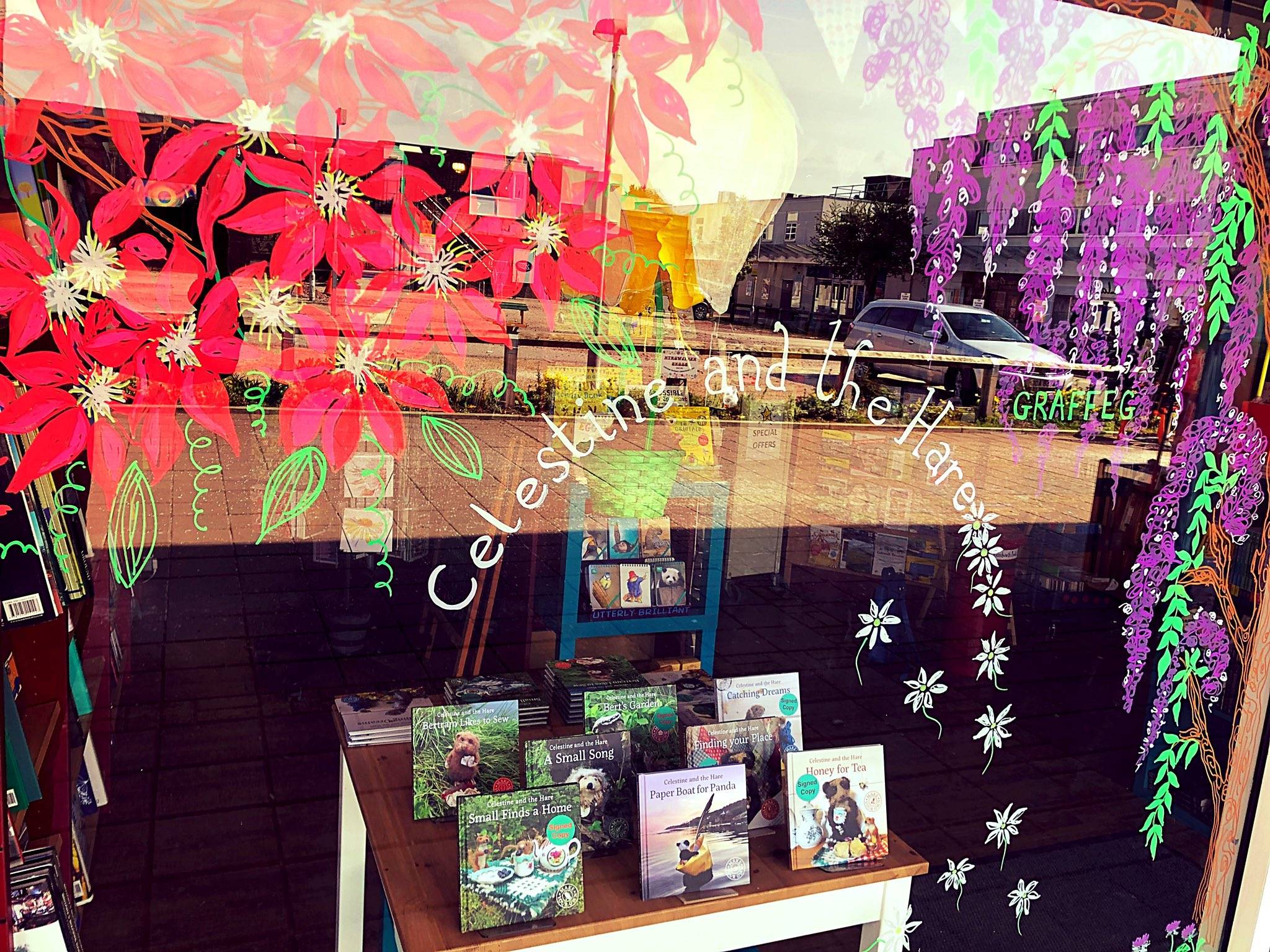
Helping Hedgehog Home window display at Kenilworth Books
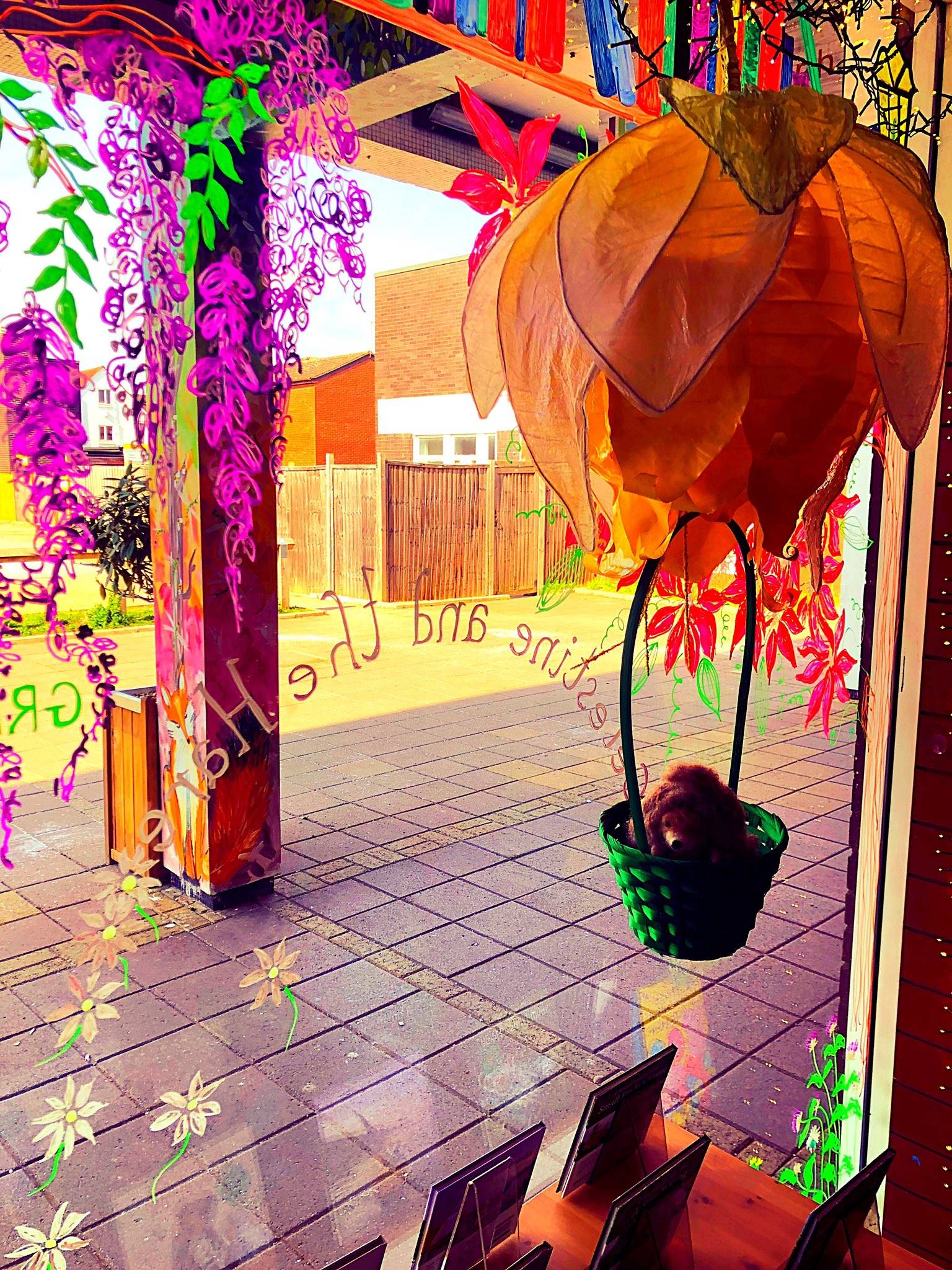
Hedgehog in a hot air balloon crafted by Tamsin with repurposed Gardners packaging
All your past projects have been solo. How does this differentiate to working with another illustrator?
KC: It was quite a change for me! I usually work on text and images together at the same time, sometimes taking the photos before I’ve fully written the text. I can work at my own timescale and have the time to ponder words alongside pictures, I fiddle back and forth and then send the whole thing off when I’m happy with it. This time I had to fix the words early on and plan out who was doing what so Tamsin could do the paintings. It meant that I wrote the book and took some photos and then had to wait a few months while Tamsin painted her images and Joana [senior designer at Graffeg] merged them together and then go back to check the words again after that wait.
It is interesting to see someone else’s imaginings of your words. Sometimes Tamsin painted what I had imagined, sometimes something even more beautiful than I could have wished for, and sometimes something completely different. But there is such a joy in the unknown and allowing your work to be seen in a new way by someone else. It brings another dimension to it and adds another layer of depth and meaning. Much harder work, but the result was worth it. It has become such a thing of beauty.
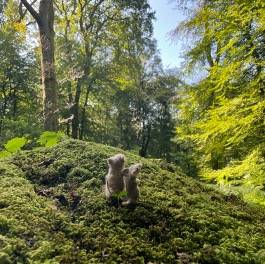
Original photograph taken by Karin
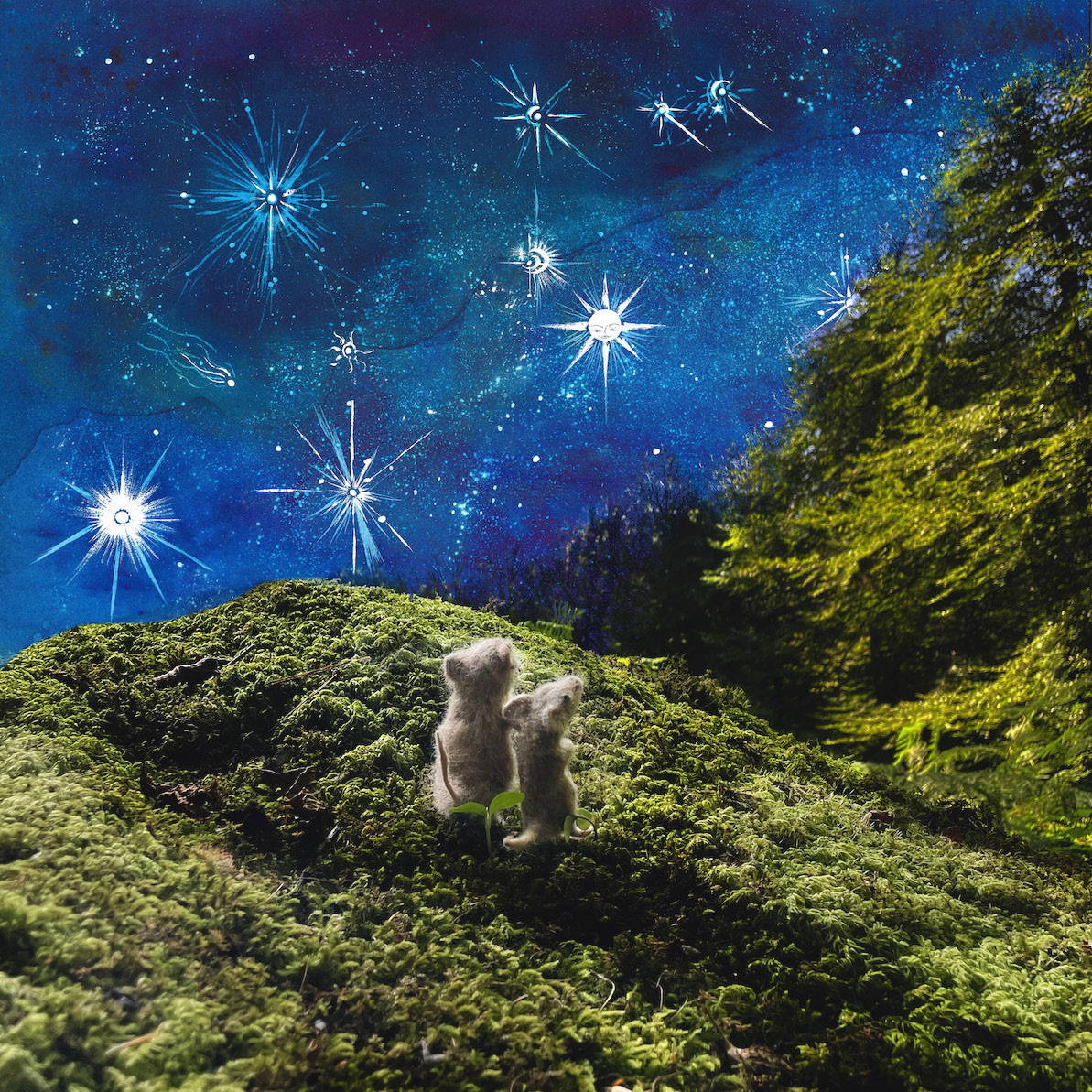
Final product with Tamsin's artwork

Original photograph taken by Karin
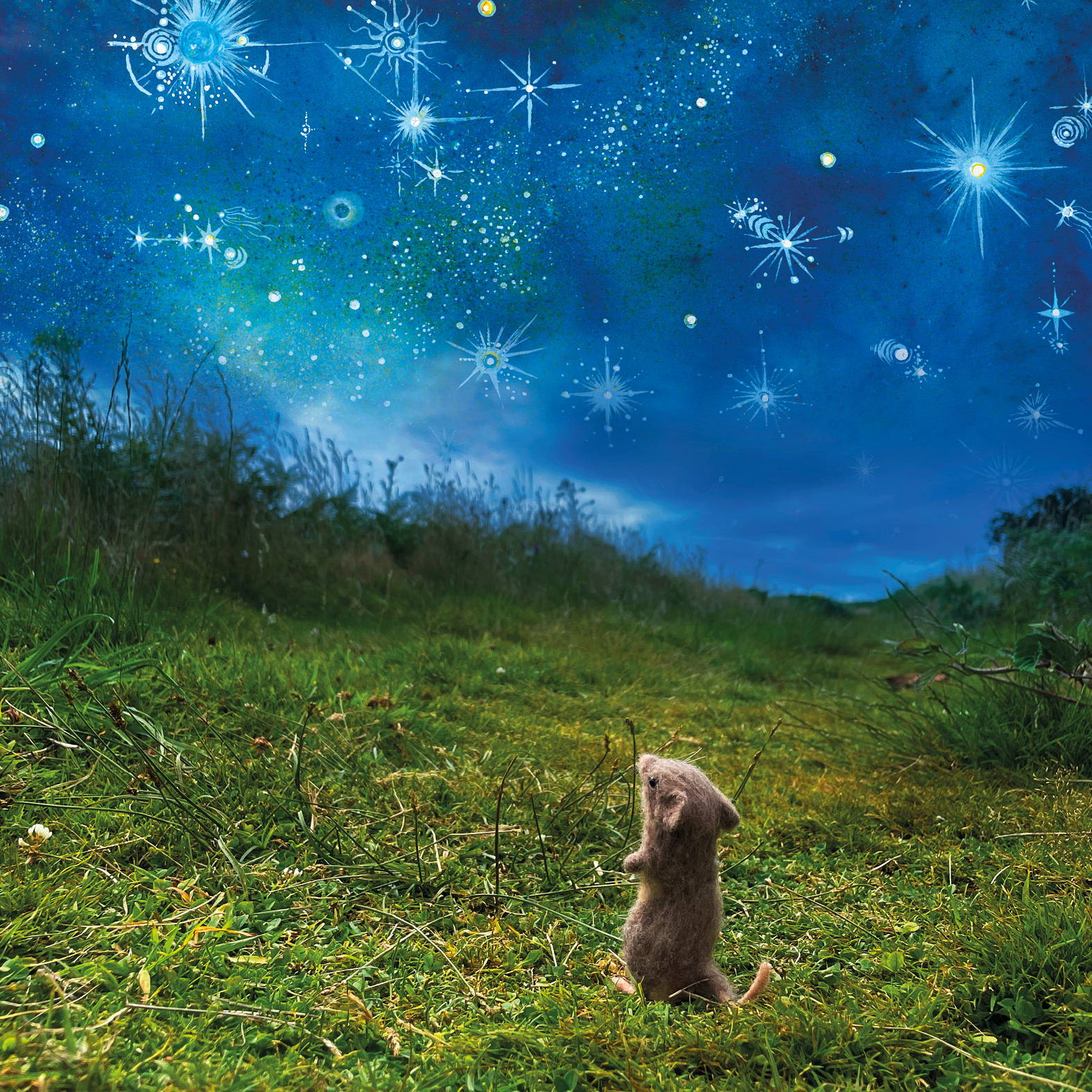
Final product with Tamsin's artwork
Can you describe the collaboration process involved in creating this book?
TR: It was a three-way collaboration really – it was designer Joana who brought the two sets of images together. We were very conscious that we were attempting something unusual: illustrating a book with a combination of photography, traditional painting and digital manipulation. It has always annoyed me that the book industry finds it so hard to see photography as a form of illustration; photographic illustration is most often totally overlooked for book prizes, for example. We were curious to see how people reacted to the concept of two illustrators, with very different media, working together.
There were some bits that were a more direct collaboration – the moths, for example! I dyed sheets of silk paper and painted them with gold powder and a chemical binding medium called Ormoline. I then cut out and posted ten sets of double wings, complete with little thorax pieces (so fifty tiny pieces of silk paper), pinned them carefully and pressed them flat and posted them to Karin. Karin then made little needle-felted bodies and attached my wings. So the moths in the photograph are both of our work – in terms of ownership, I suppose we have joint custody of the moths!
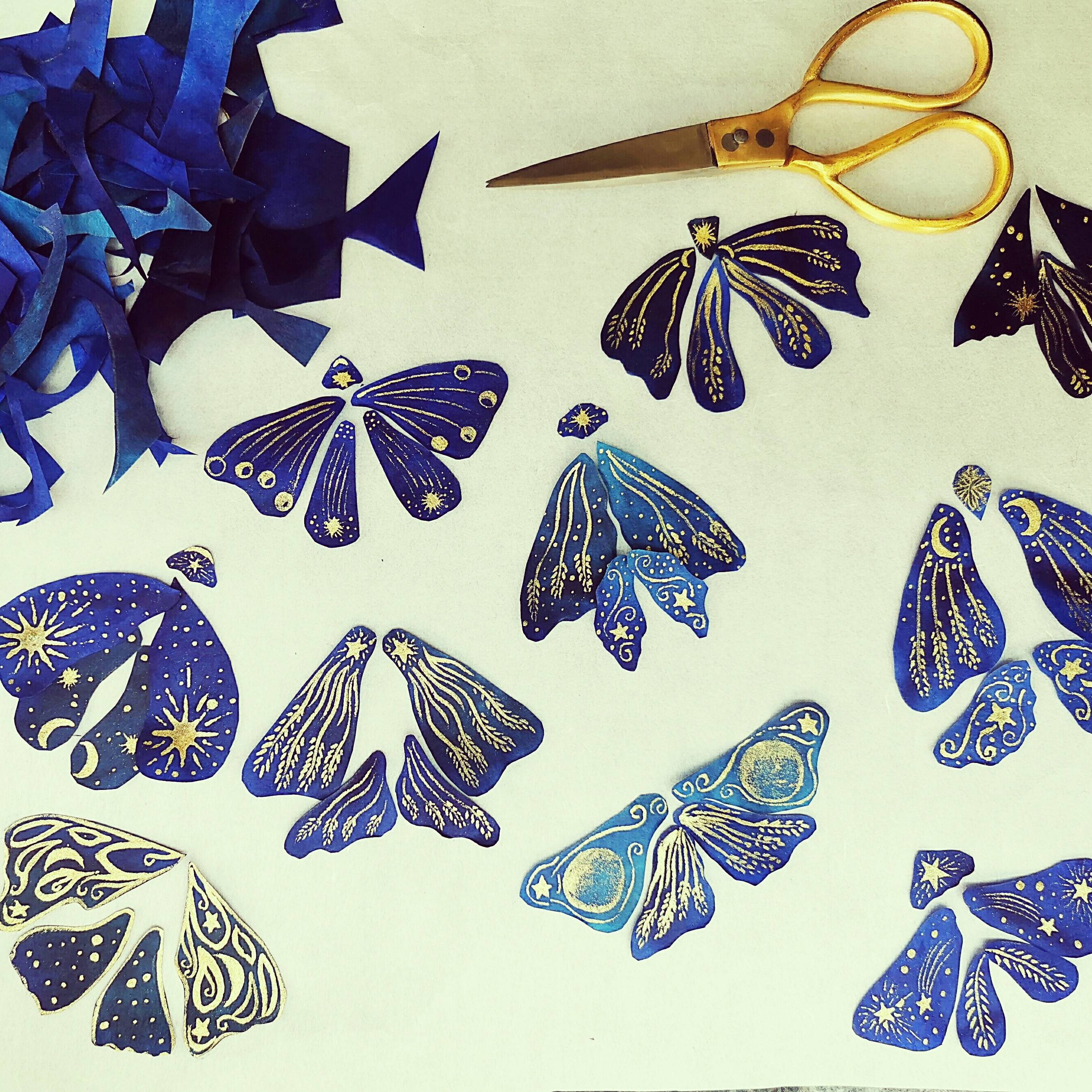
Moth wings drying

Karin's photograph
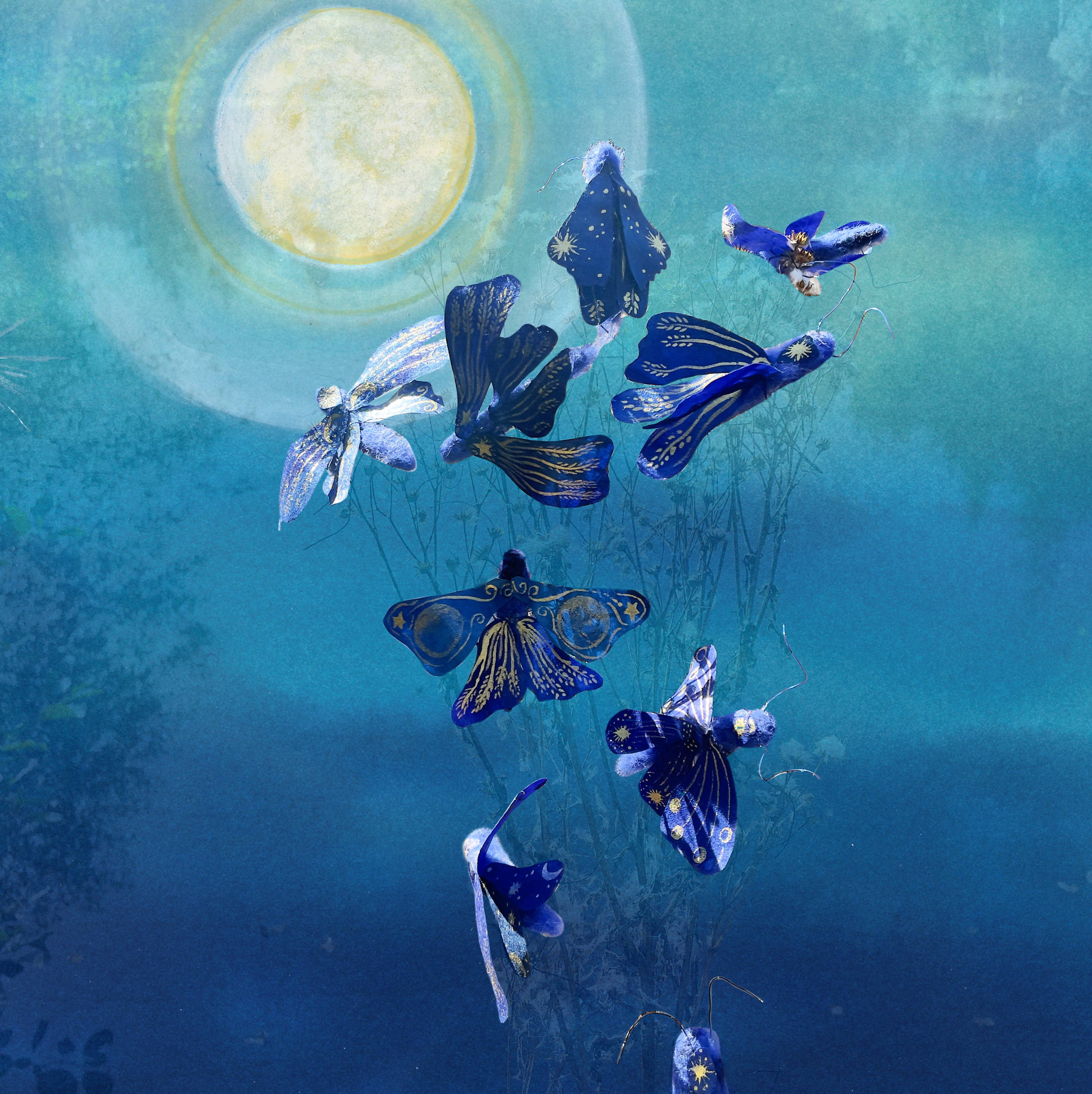
Final artwork
Can you talk us through the picture book process?
KC: You get a timeline for when they need everything, this time there were more people involved, so different deadlines for text, photos and Tamsin’s images.
Once you have words and pictures, you send them off to Graffeg with a ton of notes of this page and that page and the designer puts them on the pages and arranges it as they imagine unless you have already said this is the text for each page, which is what I tend to do as I work alongside the illustrations. There is then a lot of drafts and back and forth. I think this book had seventeen big drafts and a lot of tweaks inbetween.
Pam Thom- Rowe writes the seasonal folklore Customs in the books and they need to link with the story so there is a bit of back and forth asking her about customs, putting some in the book, sending her the story so she can link them in and then double checking we both link with themes.
Then lots of tweaks to pictures or text. It gets sent to everyone to comment and luckily Tamsin and I agreed on changes we wanted with images.
I am also lucky to have some fantastic help in the shape of my friend Cecilia Hewett, who does editing and proofreading for me before I send it off to Graffeg. Because she knows me so well, she knows what I’m trying to say and will sometimes suggest tweaks such as swapping the order of two pages round.
Once everyone is happy with the format, it goes to print and then one sits nervously waiting that all will be well and it will be as beautiful as you imagined. People have this idea of a lone author working away but there are so many people involved to make something beautiful and I’m lucky to have a team who understand what I’m trying to get across and who work together – it makes for a beautiful creation.
Can you talk us through the steps you take in creating the illustrations for The Wish Gatherers?
TR: Yes! The first thing to do was to get the colour right. I painted an entire concertina book with different shades of blue and Karin and I sat a selection of their creatures along it to see which shades worked best. We then chose four or five shades, from greeny blues to ultramarines and paler cornflower tones. And that was my foundation palette.
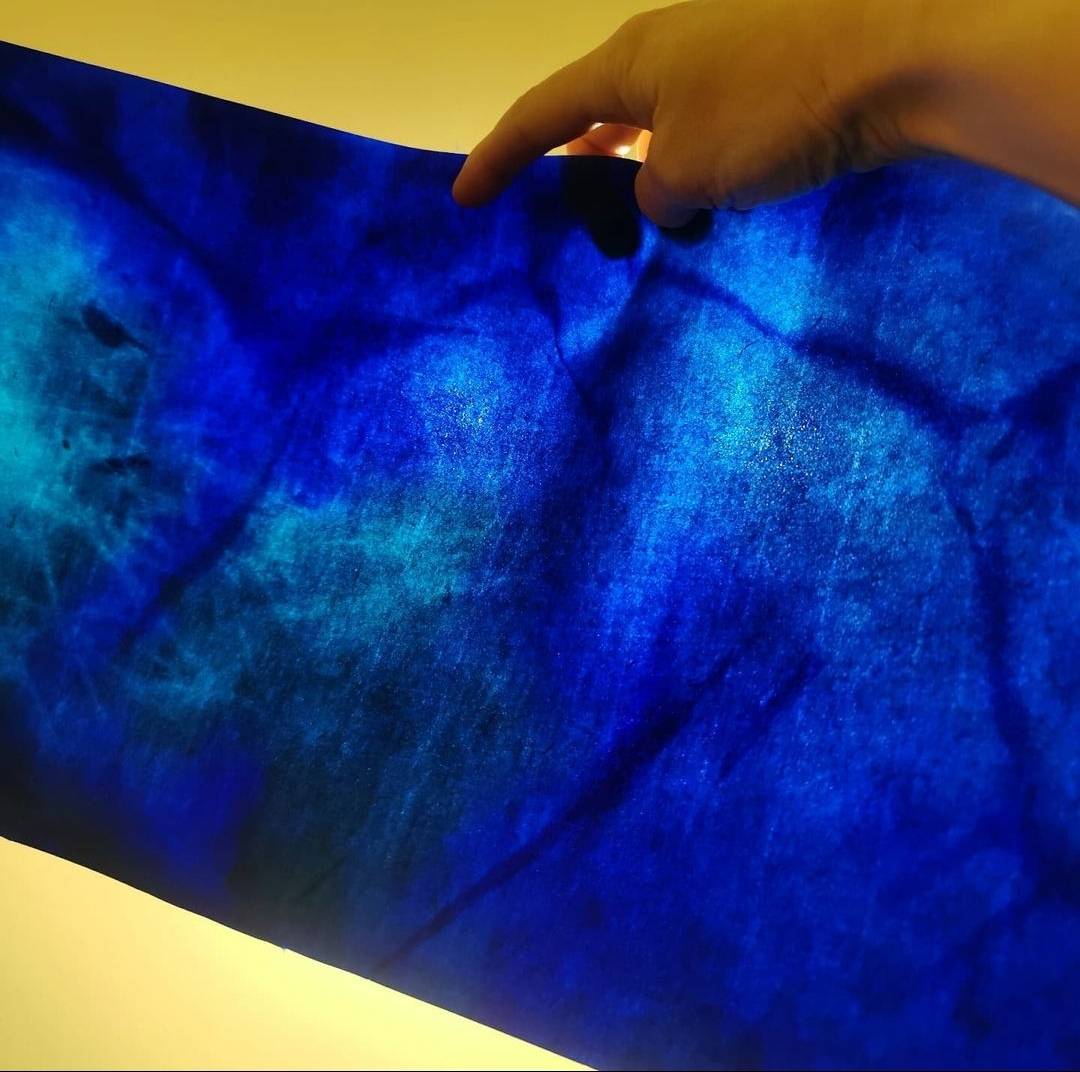
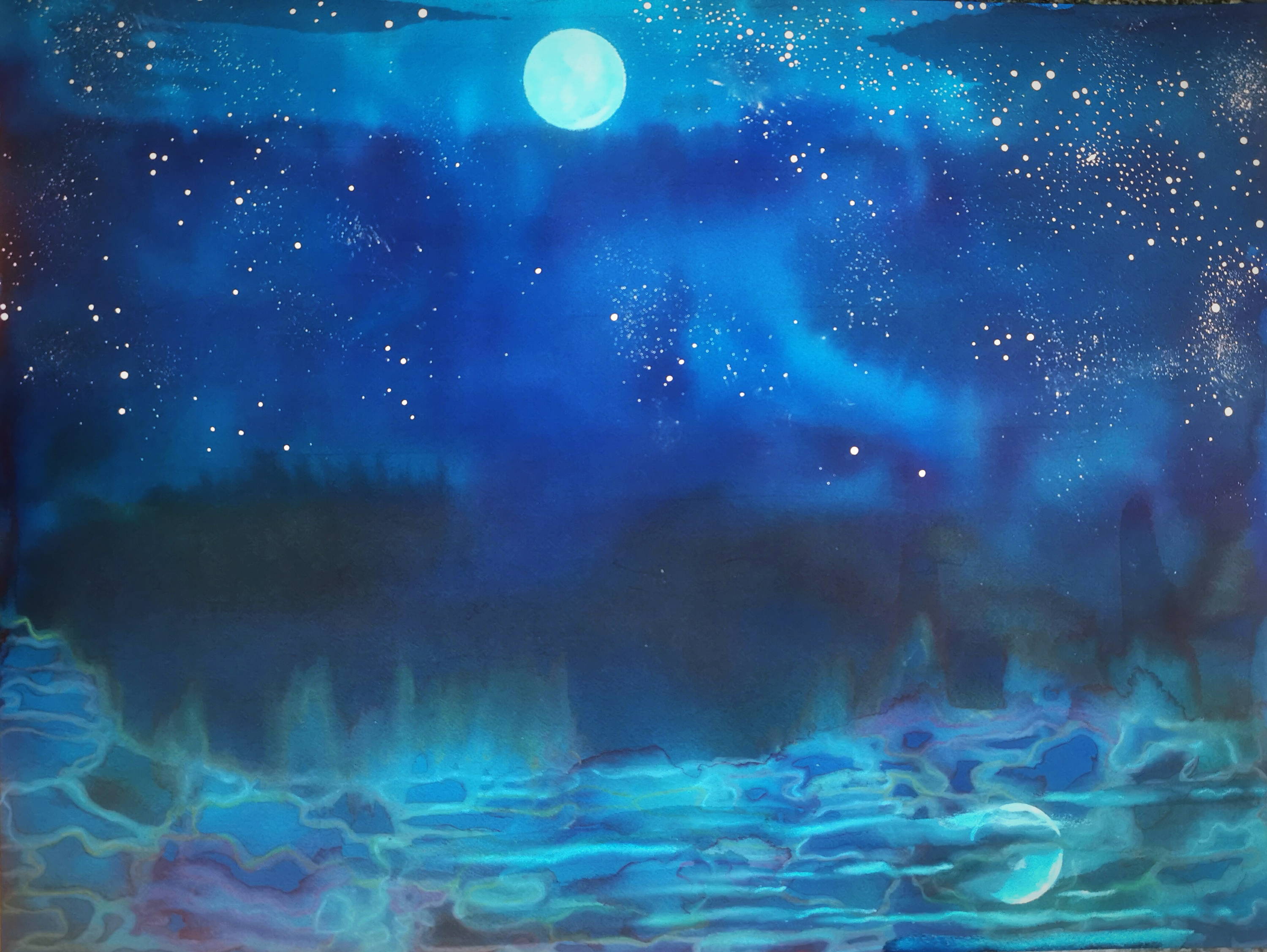
Then we needed to work out how to actually do the book. Our first idea was that I’d paint backgrounds and Karin would literally take them out into the countryside and use the paintings as backdrops – a bit like a stage set. That was our first attempt, but it wasn’t really practical – even the heaviest watercolour paper was hard to prop up and keep in place outdoors. The edges got soggy, and lighting was a challenge too. So I then painted a selection of test images of skies and stars, water and night-time forests and sent the scanned images to Graffeg designer Joana Rodrigues so she could try different ways of digitally blending my ink work with Karin’s photographs.

Experimenting with formats

Experimenting with formats
Tell us about your favourite spread in The Wish Gatherers.

Cover image
KC: I think my favourite spread is the cover image, partly because it illustrates the collaboration of everyone so brilliantly, which is such a beautiful thing about the book, my photo and animals and natural background photography and Tamsin’s beautiful skies and twinkly stars. I love the star in that image. The face is so kind smiling down and the two mice have a lovely gesture. It is also a heartfelt reminder to me of those who are no longer with us, who watch down on us. A very dear friend died while I was working on the book and it gave that image even more meaning to me.
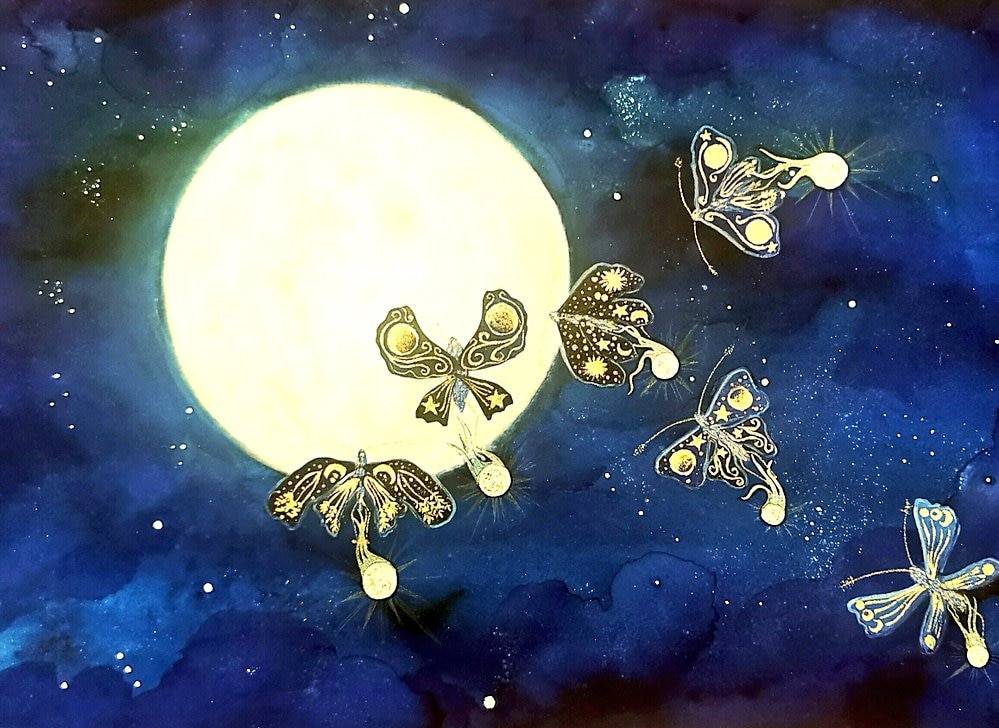
Centre page spread of the celestial moths
TR: That centre page spread of the celestial moths carrying the wishing stars back up into the sky has to be my favourite. It is peaceful and yet also has quite a powerful mythical quality to it as an image.
Have you started the next book in the Tales of the Turning Year series? If so, is there anything you can tell us so far?
KC: I have started on it whirring round in my head and have agreed a schedule for it. Because they are seasonal, the photos need to be done at the right time of year and, of course, I have to make all the characters for it too, which makes it a long process.
Next up will be summer and it will be a book that mirrors The Lightbringers in some senses with a group of creatures, but full of summer joy and inspiration and fun.
Is there anything you’d like to add for the people who will be receiving their copies of The Wish Gatherers this week?
KC: I hope they love it, I hope it touches their heart. I hope they see the depths and beauty of the book and are perhaps inspired to notice nature and autumn and look up at the skies and down at the earth. I wanted to write about how dreams and wishes don’t always come true, how some just aren’t meant to be and how we can help others’ dreams come true through hard work, kindness or a thoughtful gift at the right time. That maybe they will be inspired to help someone else find a dream and that there is joy in seeing the other come true. That working with others enhances rather than diminishes. That if you see a shooting star, you can smile, for you know that somewhere just somewhere, it was someone’s thousandth lifetime and their wish came true.
TR: Take the time to pause and really look at the illustrations. There are tiny details hidden in many of them! The images on the moths’ wings, the details in the canopies of stars, the reflections in the water…
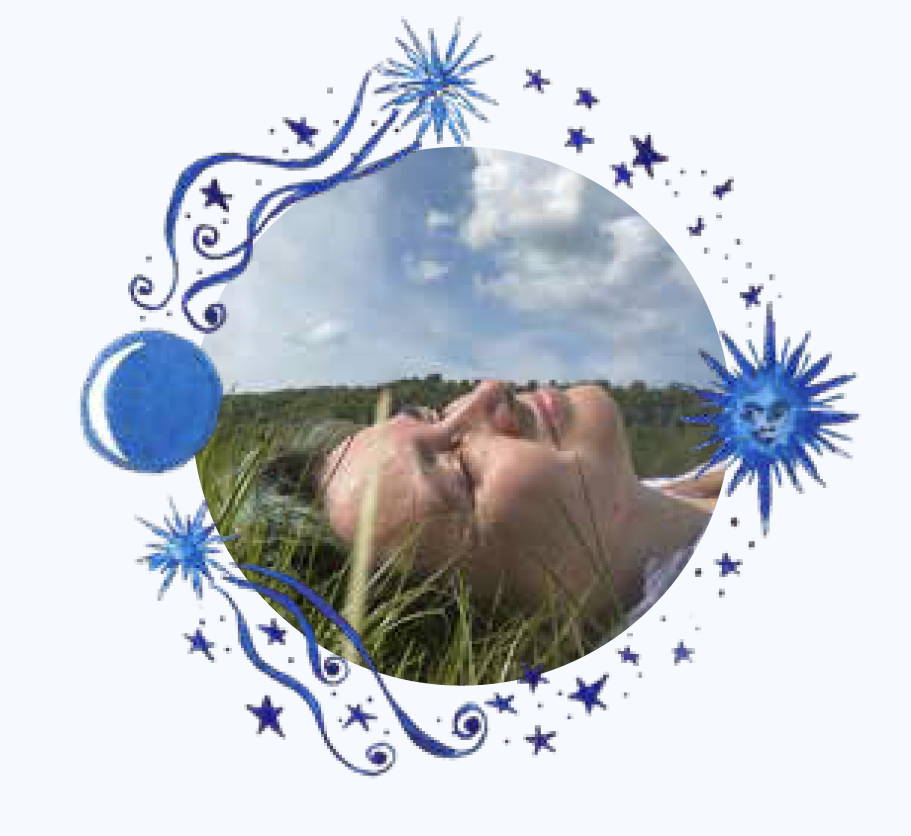
Karin Celestine lives in a small house in Monmouth, Wales. In the garden is a shed and in the shed is another world, the world of Celestine and the Hare. It is a place where kindness, mischief and beauty help people smile. Karin is an artist and author who creates needle-felted animals of charm and character, including the stars of their books, published by Graffeg.
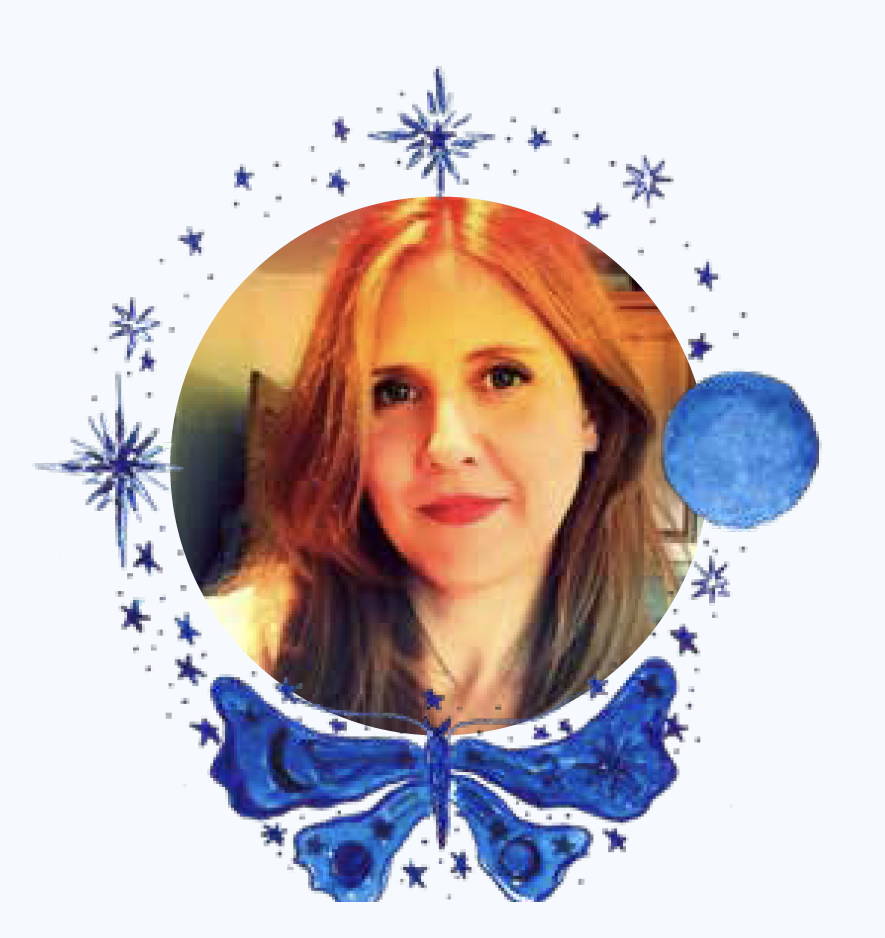
Tamsin Rosewell likes ink. She has two large cupboardsfull of ink in every colour you can imagine, collected from all over the world. On top of one of those cupboards is an Ink Monkey that Karin made for her ages ago. Tamsin illustrates book covers, designs endpapers and does all the doodly-diddly bits inside books too. She lives in the Warwickshire countryside, but much prefers London.

